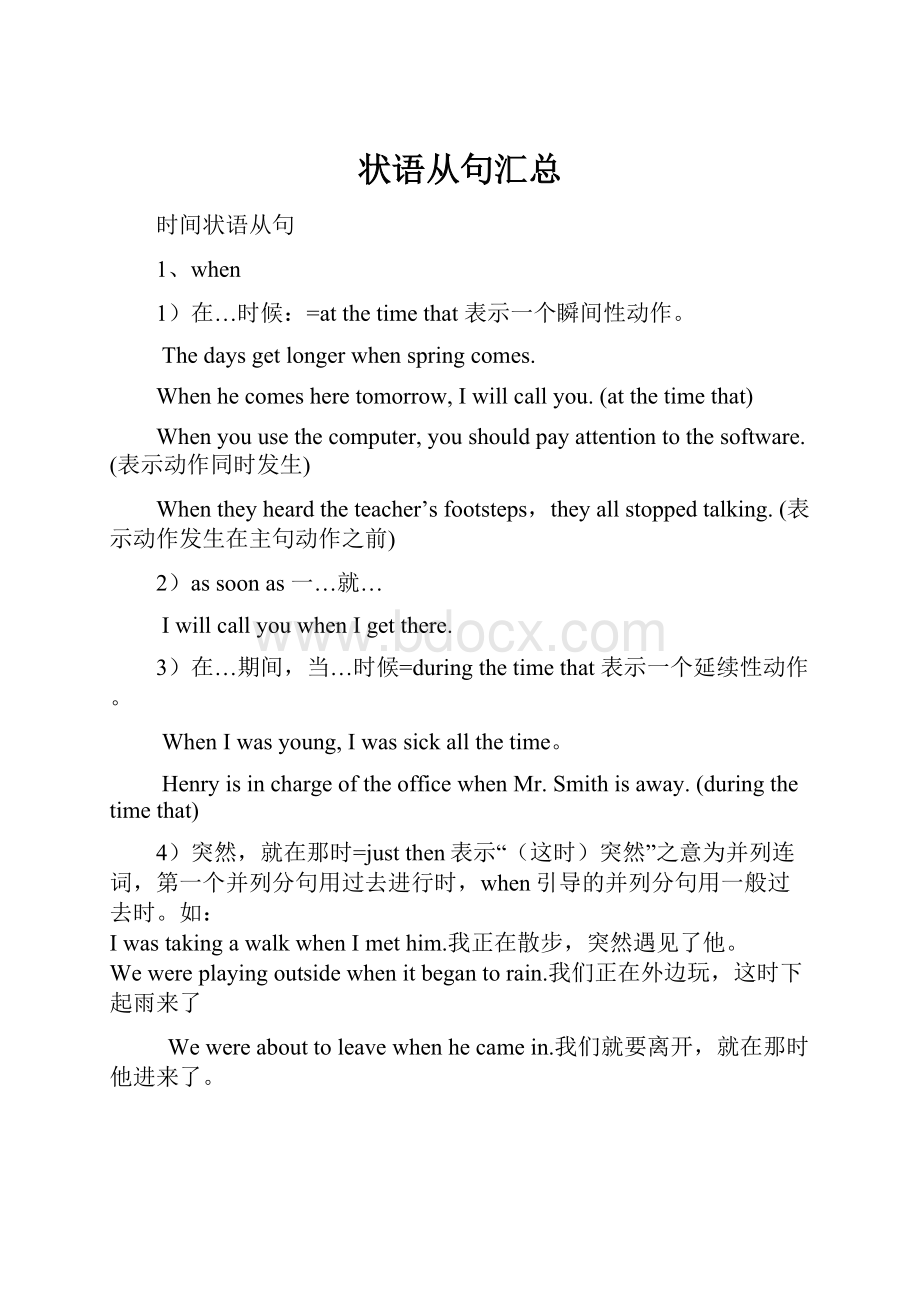状语从句汇总.docx
《状语从句汇总.docx》由会员分享,可在线阅读,更多相关《状语从句汇总.docx(36页珍藏版)》请在冰豆网上搜索。

状语从句汇总
时间状语从句
1、when
1)在…时候:
=atthetimethat表示一个瞬间性动作。
Thedaysgetlongerwhenspringcomes.
Whenhecomesheretomorrow,Iwillcallyou.(atthetimethat)
Whenyouusethecomputer,youshouldpayattentiontothesoftware.(表示动作同时发生)
Whentheyheardtheteacher’sfootsteps,theyallstoppedtalking.(表示动作发生在主句动作之前)
2)assoonas一…就…
IwillcallyouwhenIgetthere.
3)在…期间,当…时候=duringthetimethat表示一个延续性动作。
WhenIwasyoung,Iwassickallthetime。
HenryisinchargeoftheofficewhenMr.Smithisaway.(duringthetimethat)
4)突然,就在那时=justthen表示“(这时)突然”之意为并列连词,第一个并列分句用过去进行时,when引导的并列分句用一般过去时。
如:
IwastakingawalkwhenImethim.我正在散步,突然遇见了他。
Wewereplayingoutsidewhenitbegantorain.我们正在外边玩,这时下起雨来了
Wewereabouttoleavewhenhecamein.我们就要离开,就在那时他进来了。
2、as引导的动作既可以是延续性也可以时瞬时性。
一般用于主句和从句动作同时发生。
当…时候,一边…一边,随着。
还可以强调句中两个动作紧接着先后发生,而不强调主句开始的特定时间。
1)Hesmiledashestoodup.
2)Asthestudentswalkedtotheirclassroom,theysonghappily。
3)As the time went on,the weather got worse.
4)Aswewasgoingout,itbegantosnow.当我们出门时,开始下雪了。
(强调动作紧接着发生)
3、while意为“当……时候”,指一段时间,不能用来表示一个时间点。
引出的从句动作是延续性的,并且强调从句动作和主句动作同时发生,并且while强调主句表示的动作是在while从句的动作延续中发生。
1)Whilehewaswalkinginthestreet,hemetTim.
2)Hevisitedalotofplaceswhilehewastraveling.
3)Iwascookingdinnerwhile/whenhewasplayingthepiano.
4、whenever,everytime(when,that),eachtime(when,that)任何时候,每当
1)Everytime/eachtimeIcatchacold,Ihavepaininmyback.
2)Whenever/eachtime/everytimeImether,shewasstudying.
5、before,after
Before在…之前,表示主句动作发生在从句动作之前。
当主句用将来时,从句用现在时;从句是过去时,那么主句多用过去完成时,这样以便体现动作发生的先后。
1)Mr.Brownhadworkedinabankforayearbeforehecamehere.
2)Einsteinalmostknockedmedownbeforehesawme.
3)MyfatherhadleftforCanadajustbeforetheletterarrived.
注意before引导的从句不再用否定式的谓语,并且当before引导的从句位于主句之后,有时译成“就,才”。
Itwillbefourdaysbeforetheycomeback.他们要过四天才能回来。
Einsteinalmostknockedmedownbeforehesawme.爱因斯坦几乎把我撞倒才看到我。
Theyhadnotbeenmarriedfourmonthsbeforetheyweredivorced.他们结婚还不到四个月就离婚了。
After表示主句动作发生在从句动作之后。
主句和从句的动作的时间关系正好与before引导的从句相反。
1)Afteryouthinkitover,pleaseletmeknowwhatyoudecide(决定).
2)Afterwehadfinishedthework,wewenthome.
6、till/until到…为止,(直到…才,在…之前)
till和until一般情况下两者可以互换,要注意的是:
1)如果主句中的谓语动词是瞬时动词时,主句必须用否定形式;直到…才,在…之前
(1)Ididn'tgotobeduntil(till)myfathercameback.
(2)Iwon’tgowithyouuntil(till)Ihavefinishedmyhomework.
2)如果主句中的谓语动词是延续性动词时,用肯定或否定形式都可以,但表达的意思不同。
例如:
(1)Iworkeduntilhecameback.我工作到他回来为止(到…为止)
(2)Ididn'tworkuntilhecameback.直到他回来我才开始工作(直到…才)
(3)PleasewaituntilIarrived.请等到我来了为止;在我到来之前,请等待。
3)在强调句型中多用until
Itis/wasnotuntil…that…直到…才
(1)ItwasnotuntilthemeetingwasoverthathebegantoteachmeEnglish.
(2)Hedidn’tbegintoteachmeEnglishuntilthemeetingwasover.
(3)ItwasnotuntilshetookoffherdarkglassesthatIrealizedshewasafilmstar.
(4)=Ididn’trealizeshewasafamousfilmstaruntilshetookoffherdarkglasses.
7、since,eversince自从,从…以来,从那时起一直到现在;此后一直,since引导的从句的谓语动词可以是延续性的动词,又可以是瞬时动词。
一般情况下,从句谓语动词用一般过去时,而主句的谓语动词用现在完成时。
1)IhavebeeninBeijingsinceyouleft.
2)WherehaveyoubeensinceIlastsawyou?
3)wehavenevermetsincewegraduatedfromschool.
4)MrGreenhastaughtinthatschoolsincehecametoChinathreeyearsago.
5)Ihaveknownhimeversincehewasaboy.
在Itis+时间+since从句的句型中,主句多用一般现在时。
表示的意思是:
从…以来多长时间了
1)Itistwoyearssincewemovedhere./ithasbeentwoyearssincewemovedhere.
2)Itisfiveyearssincewemetlasttime.
注意:
在连词since引导的时间状语从句中,用终止性动词的过去时或用延缓性动词过去时,其含义是大不相同。
A、since所引导的时间状语从句中,如果句子谓语是瞬时性性动词的过去时,则从句表示的时间是从“那一时刻开始”:
Hehasstudiedveryhardsincehecametoourschool.
B、since所引导的时间状语从句中,其谓语是持续性动词的过去时,那么从句所表示的时间是从持续性动词所表示的动作结束时算起:
Ihaven’theardanynoisesinceIslept=(wokeup).“我醒后还未听到任何声音”。
C、since所引导的时间状语从句中,其谓语是持续性动词的现在完成时,则表示动作和状态延续到现在(说话时刻),那么从句所表示的时间是从动作发生之时算起:
Ihaven’theardfromhimsincehehaslivedthere。
这里has lived表示动作的持续性,时间的起点应从:
“开始居住”时算起。
因此此句可理解为“自从他(开始)住在那儿起,我就一直没收到他的来信”。
总结:
由此可见,since引导的从句持续动词的一般过去时和现在完成时所表示的意思恰好相反。
换言之,前者以肯定的语法形式反映着否定的逻辑内容,而后者的形式与内容是一致的。
比较:
SinceI’vebeenatthisschool,wehavehadthreeheadmasters.
SinceIwasatthisschool,theyhavehadthreeheadmasters.
HehasneverbeentoseemesinceIhavebeenill.
HehasneverbeentoseemesinceIwasill.
注意:
在“itis…since”结构中,since引导的从句绝对不能用否定式的谓语动词来表示否定的意义。
Itisalongtimesincehedidn’tstudyEnglish.→It’salongtimesincehestudiedEnglish
It’stwomonthssinceyoudidn’tcometoseeme.→Youhaven’tcometoseemefortwomonths.
8、由assoonas,immediately,directly,instantly,themoment,theinstant,theminute,等引导的时间状语从句。
这些连词都表示从句动作一发生,主句动作随即发生,常理解为“一….就…”“刚…就…”
1)Iwillgotheredirectly/immediately/instantlyIhavefinishedmybreakfast.
2)Assoonaswegothome,thetelephonerang.
3)Iwanttoseeherthemoment/instant/minute(that)shearrives.
4)Isentyouthenewstheinstant(that)Iheardit.
9、hardly(scarcely,rarely)…when/before,nosooner…than相当于assoonas之意,他们只用于过去时,主句一般用过去完成,从句用过去。
1)Hehadnosoonerarrivedhomethanhewasaskedtostartonanotherjourney.
2)Thesunhadnosoonerrisenthanhebegantowork.
3)Ihadhardlysatdownwhenhecamein.
4)Hehadhardlyfallenasleepwhenhefeltatouchonhisshoulder.
5)Thewordshadnosoonerbeenspokenthanherealizedthathadmadeabigmistake.
6)Hehadhardlyreachedtheairportwhentheairplanetookoff.
当hardly,scarcely,rarely和nosooner位于句首时,主句应用倒装语序,基本结构如下:
Hardly(Scarcely,Rarely,Nosooner)+had+主语+其他….+when或than引导的从句,例如:
HardlyhadIreachedtheairportwhentheirplanetookoff.
10、bythetime到…为止(主句一把用完成时)
在一般情况下,如果从句的谓语动词用一般过去时,主句的谓语动词用过去完成时,如果从句的谓语动词用一般现在时表示将来的动作时,主句的谓语动词用将来完成时。
1)Bythetimehegetsthere,hisfatherhasalreadygone.
2)BythetimeIgottoschool,theclasshadalreadybegan.
3)Bythetimeyoucomeheretomorrow,Iwillhavefinishedthiswork.
11、由aslongas和solongas引导的时间状语从句。
这两个连词表示“有多久……就多久”。
例如:
Youcangowhereyoulikeaslongasyougetbackbeforedark.你可以随意到哪里去,只要在天黑以前回来就行。
Iwillfightagainsttheseconditionsaslongasthereisabreathinmybody!
只要我一息尚存,我就要反对这种境况。
重点难点
as,when,while都是引导时间状语从句(adverbialclauseoftime)的从属连词。
它们的用法和区别如下:
1、如果甲事件发生在乙事件的过程之中,而且乙事件有延续性,甲事件无延续性或只有较短的延续性,这时as,when,while都可使用,但while强调过程或时间段内的含义,而as最为口语化。
Aswewerewalkingpastashop,heheldadiamondfirmlyagainstthewindowandmadeadeepimpressionintheglass.(此处也可换用when或while,若用while则强调就在走路的过程中。
)When/While/Ashewaseatinghisbreakfast,heheardthedoorbellring.当他在用早餐的时,听到门铃响了。
(while强调吃早餐的过程。
)
2、如果两个事件的发生在时间上没有先后之分,或是没有明显的先后之分时,我们称之为同时性(sametime)。
两个同时发生的事件如果都有延续性,而且延续时间大致相等时,用when或while,不用as。
Iwascookingdinnerwhile/whenhewasplayingthepiano.=Icookeddinnerwhile/whenheplayedthepiano.他在弹钢琴的时候我在做饭。
(两句意义基本相同,用进行时更加突出事情的持续性。
)
3、两个同时发生的事件如果都没有延续性,用when或as,不用while:
Thedogbarkedwhen/asitheardanoise.狗听到声音,叫了起来。
4、两个同时发生的事件如果不是一次性的,而是重复性的动作,即过去或现在的习惯性动作,那么只能用when,不能用as和while,表示“每当,··…的时候”,相当于“whenever,everytime”
When=(Whenever/Everytime)hegoestotown,healwaysvisithisaunt.每次他去城里时,他总是去看望他的姑姑。
5、不强调特定的时间性,只是说明两个紧接着的动作时,多用as;as有时还可用来表示“随着”的含义。
AsIwasgoingout,itbegantorain.当我出门时,开始下雨了。
(强调两个动作紧挨着。
)
Asspringwarmsthegoodearth,allflowersbegintobloom.随着春回大地,百花开始绽放。
(表示“随着”,不用when或while)
6、when有时还可作为并列连词,用于引导无延续性事件的分句,这时when分句不同于时间状语从句,而是相当于一个并列分句,表示“andatthattime";while和as均无此功能。
注意:
与第一类情况相区别,前者时间状语从句中多用进行时,主句不用进行时,而此处是when分句不用进行时。
Hewasstillmumblingsomethingabouthospitalsattheendofthepartywhenheslippedonapieceoficeandbrokehisleftleg.(=andatthattime)(表示“就在那时”。
)
IwascookingthedinnerwhenIbrokeaglass.我正做着晚饭,突然打碎了一个玻璃板。
比较:
Ibrokeaglasswhen/while/asIwascookingthedinner.我在做饭的时候打碎了一个玻璃板。
7、while也可以作为并列连词,连接两个独立的句子,但它表示的是语义的转折和对比,相当于whereas.when和as都无此用法。
Jeanisslender,whileMaryisstout.
as表示"当……时""一面……一面","随着"。
其具体用法如下:
1、表示"当……时"、"和……同时"。
常指从句的动作未结束,主句中的动作就已发生。
从句中多用表示动作的动词,而不用be动词或表示感觉、理解、知道这类动词。
Ashestoodthere,hesawtwomenenterthebar.
Shedroppedtheglassasshestoodup.
AsIwaswalkingdownthestreet,anAmericanaskedmefordirectionstotheneareststation.
2、当主句、从句动作同时进行,从句动作的时间概念淡化,只能用 as。
这时as常表示“一边…,一边…”之意,常指一个主语的两种动作同时交替进行。
如:
Hesangasheworked.
Thestudentstooknotesastheylistened.
The little girls sang as they went.小姑娘们一边走,一边唱。
The sad mother sat on the roadside,shouting as she was crying.伤心的妈妈坐在路边,边哭边叫。
3、用于平行发展的结构中,表示"随着……"。
表示主句动作发生的背景或条件,或一种状态随另一种状态变化。
句中的动词多表示状态的发展变化。
As the time went on,the weather got worse.(as表示“随着……”之意)
The atmosphere gets thinner and thinner as the height increases.
As years go by,China is getting stronger and richer.
Asthewindrosethenoiseincreased.
Asitgrewdarkeritbecamecolder.
Ashegrewolderhebecamemoreconfident.
4、表示两个短动作或事件几乎同时发生,最常用的是as或justas,也可用when
AsIwasgoingout,itbegantorain.As(强调句中两个动作紧接着先后发生,不是强调开始下雨的特定时间)
Ithoughtofitjustasyouopenedyourmouth.
Justastheflyingwormhitherface,shegavealoudcry.
While表示"在……的时候"、"在……期间"。
它强调主句的动作发生在从句的动作过程中。
While从句中必须是表示动作或状态的延续性动词。
如:
Nevergetonoroffabuswhileitisinmotion.
TheweatherwasfinewhilewewereinBeijing.
ShecalledwhileIwasout.
1、如果主句的动作在从句的动作过程中发生,从句常用进行时。
如:
Whilewewereswimmingsomeonestoleourclothes.
Don’ttalksoloudwhileothersareworking.
2、如果主句和从句主语相同,while加现在分词可代替状语从句。
如:
Wemuststrikewhiletheironishot.
HetookabathwhileIwaspreparingdinner.
Comeandpayavisittotheparkwhiletheflowersareinbloom.
时间状语从句练习题
1._________hecomestomorrow,Ishallaskwherehehasbeen.
2._________hewasspeaking,everybodylistenedcarefully.
3.Isawherjust_________shewasgettingoffthetrain.
4.Haveagoodlookatthat